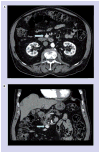Insulinoma: pathophysiology, localization and management
- PMID: 20146582
- PMCID: PMC3498768
- DOI: 10.2217/fon.09.165
Insulinoma: pathophysiology, localization and management
Abstract
Insulinoma is a rare neuroendocrine tumor that causes oversecretion of insulin and, as a result, patients present with symptoms of hypoglycemia. Fortunately, insulinomas are usually benign and solitary, and surgical cure rates are highly favorable. Most of these tumors occur sporadically, but they can also be associated with multiple endocrine neoplasia type-1 syndrome. The diagnosis is confirmed by a supervised fast, and early detection is important. Several preoperative and intraoperative techniques with various success rates have been employed in order to localize the lesion. When technically feasible, tumor enucleation is the procedure of choice; however, a more formal resection may be necessary for certain tumors. In the age of laparoscopy, the role of laparoscopic surgery in the management of insulinomas is continuing to attract attention. This review will discuss the historical background, pathogenesis, diagnosis, localization and management of insulinomas.
Figures
References
-
- Service FJ, McMahon MM, O’Brien PC, Ballard DJ. Functioning insulinoma – incidence, recurrence, and long-term survival of patients: a 60-year study. Mayo Clin Proc. 1991;66:711–719. Defines the incidence and long-term outcome of sporadic and multiple endocrine neoplasia type (MEN)-1 associated insulinoma. - PubMed
-
- Banting FG, Best CH. The internal secretion of the pancreas. J Lab Clin Med. 1922;7:251–266. - PubMed
-
- Wilder RM, Allan FN, Power MH, Robertson HE. Carcinoma of the islands of the pancreas: hyperinsulinism and hypoglycemia. JAMA. 1927;89:348–355.
-
- Grant CS. Insulinoma. Baillieres Clin Gastroenterol. 1996;10:645–671. - PubMed
Publication types
MeSH terms
Grants and funding
LinkOut - more resources
Full Text Sources
Medical

